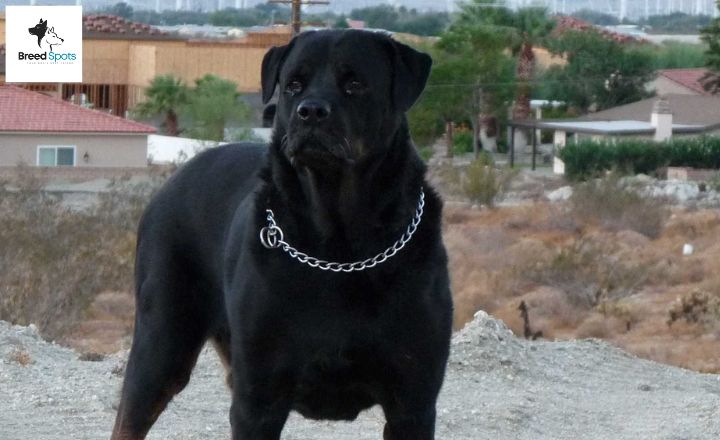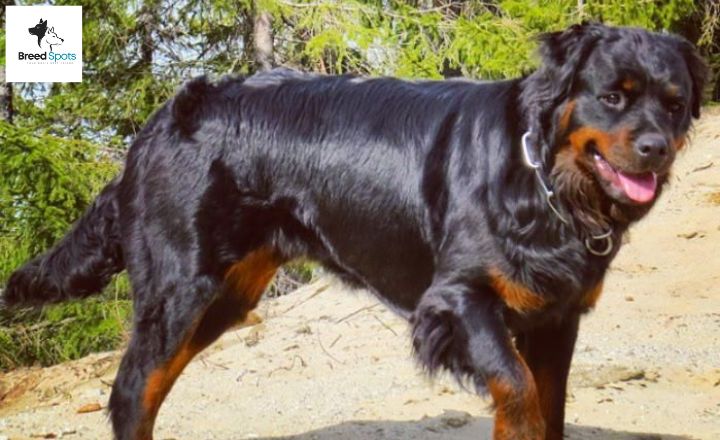Do you know all the possible Rottweiler colors and coat types? Let’s learn all there is to know about all the various hues and shades these pups can come in.
This classic look has made them one of the most recognizable breeds in the canine world. However, behind this traditional façade lies a hidden spectrum of colors and patterns that many dog lovers are completely unaware of.
The Rottweiler breed is not just a one-color wonder; it boasts an astonishing array of hues that challenge our perceptions and add depth to its already rich history.
In this article, we’ll explore seven unique Rottweiler colors that break the mold and showcase the breed’s remarkable diversity
Rottweiler Color Overview
| Recognized | Standard | |
| Black | No | No |
| Black and mahogany | Yes | Yes |
| Black and tan | Yes | Yes |
| Black and rust | Yes | Yes |
| Red | No | No |
| Blue | No | No |
| White | No | No |
Standard Coat Colors
When it comes to canine aesthetics, coat color is more than just a visual feature; it’s a captivating reflection of a dog’s breed, genetics, and even personality.
Standard coat colors can evoke emotions or memories—a fiery red can ignite the spirit of adventure while a soft golden hue often conjures warmth and companionship.
The vibrancy of these colors not only serves functional purposes in nature, such as camouflage or mating signals, but also influences how we perceive and connect with our furry friends. Interestingly, the genetic mechanisms underlying dog coat color are intricate and diverse.
Additionally, some coats exhibit unique characteristics like merling—a dappled effect that adds depth to hues.
1. Black And Mahogany Rottweiler

The Black and Mahogany Rottweiler is a striking example of this robust breed’s beauty and strength.
With its rich mahogany markings contrasting sharply against a deep black coat, this variation showcases not just aesthetics but also the breed’s heritage.
These colors are indicative of a healthy lineage, often linked to working dogs bred for their strength and intelligence.
Owners of Black and Mahogany Rottweilers often speak of the pride they feel when out walking their dogs; people can’t help but stop and admire their powerful stance and confident behaviour.
2. Black And Tan Rottweiler

The Black and Tan Rottweiler captivates not just with its striking color pattern, but also with a blend of historically rich traits that make it an exceptional companion.
This variation sports a glossy black coat complemented by eye-catching tan markings on the face, chest, and legs—each feature accentuating its robust physique.
These dogs are a testament to their lineage; originally bred for herding and guarding livestock, they carry an innate sense of duty that translates into loyalty beyond measure.
3. Black And Rust Rottweiler

The Black and Rust Rottweiler, distinguished by its striking coloration, holds a special place in the hearts of dog lovers.
This breed’s deep black coat melded with rich rust markings not only contributes to its robust aesthetic but also serves as a reminder of the Rottweiler’s origin as a working dog.
Their appearance exudes confidence and strength, making them a formidable presence, yet it’s their intelligence and loyalty that truly resonate with owners.
Non-standard Coat Colors
The captivating allure of Rottweilers often lies in their striking black and tan coloration, but the world of non-standard coat colors brings an exciting twist to this beloved breed.
Rarely seen shades like blue, chocolate, or even merle have begun to pique interest among dog enthusiasts and breeders alike.
These unique hues result from specific genetic combinations that challenge traditional perceptions of what a Rottweiler should look like.
While some may question the legitimacy of these variations, they represent the beauty of genetic diversity within the breed.
1. Black Rottweiler

The Black Rottweiler, often characterized by its striking coat and powerful build, commands attention wherever it goes.
Unlike their traditional counterparts, the black variant’s deep jet-black fur has become a sought-after aesthetic among dog lovers.
This breed not only boasts physical beauty but also possesses an intense loyalty that is unmatched in the canine world; they are guardians by nature with a gentle disposition toward their families.
However, the misconception that all Rottweilers are aggressive often overshadows their affectionate side.
2. Red Rottweiler

The Red Rottweiler, often regarded as a striking variant of the famously loyal breed, brings a unique aesthetic flair to the traditional appearance of its black-and-tan counterpart.
This captivating coat can vary in shades, ranging from deep mahogany to brilliant copper, enhancing the dog’s robust physique and undeniable presence.
The vivid coloration not only turns heads but also sparks discussions among enthusiasts about how genetic variations affect temperament and health in this magnificent breed.
Beyond their stunning appearance, Red Rottweilers embody a blend of strength and gentleness that embodies the true essence of companionship.
These dogs are inherently protective yet incredibly affectionate with family members, making them superb guardians and devoted friends.
3. Blue Rottweiler

The Blue Rottweiler is a stunning variation of the traditional Rottweiler, distinguished by its unique coat color that can elicit amazement and admiration.
While these blue-coated canines often captivate attention, it’s important to understand that their striking appearance is due to a genetic phenomenon known as dilution.
This hereditary trait affects the black pigment found in standard Rottweilers, altering their coat into deeper shades of greyish-blue that many find alluring.
However, this unusual coloring comes with its share of controversy; some breeders prioritize appearance over health, leading to potential genetic issues.
Read This Article All 7 Labrador Retriever Colors And The Fun Genetics Behind Them
4. White Rottweiler

The White Rottweiler, often mistaken for a rare breed, is a variation of the traditional Rottweiler.
This striking canine boasts a coat that shines like fresh snow, which starkly contrasts with the classic black-and-tan coloring typical of its peers.
However, enthusiasts must note that this color change results from a recessive gene and does not signify an independent breed.
Not merely an aesthetic marvel, the White Rottweiler possesses all the revered traits of its standard counterparts—strength, loyalty, and intelligence.
Coat Types
There are two coat types this magnificent breed can come in. All of the shades and color combinations I’ve mentioned can come in both coat lengths.
However, most kennel clubs allow only one fur type.
Short-haired Rottweiler

The short-haired Rottweiler, often overshadowed by its longer-haired counterparts in popular media, embodies a sleek elegance that commands attention.
This breed’s tight, gleaming coat showcases the powerful musculature beneath, providing an aesthetic akin to a living statue.
Their short hair not only enhances their striking appearance but also offers practical benefits; it requires less grooming and helps them stay cool in warmer climates—a feature that can be particularly appealing for active owners in sunny regions.
Long-haired Rottweiler

Long-haired Rottweilers are a rare and enchanting variation of the traditional breed, boasting an unusual coat that can easily catch the eye.
This distinctive trait arises from a recessive gene that some Rottweilers carry, leading to soft, wavy fur that’s considerably longer than the usual short and dense hair typically associated with this loyal companion.
Owners often describe their long-haired Rotties as “fluffier” and set apart by their unique appearance, which lends them an almost regal disposition.
What Is The Rarest Color Of Rottweiler?
The rarest color found in Rottweilers is the albino variation, which deviates significantly from the traditional black and tan coat that defines the breed.
While this striking white coat may seem visually appealing, it is often accompanied by serious health issues due to genetic mutations.
Albino Rottweilers tend to have pink eyes or blue eyes, which heightens their sensitivity to sunlight and often leads to vision problems.
Because of these challenges, many breeders discourage attempts to produce such colors, emphasizing the importance of maintaining breed integrity.
Does Color Matter?
When it comes to Rottweilers, many prospective owners often fixate on coloration, but it’s essential to recognize that a dog’s personality and temperament far outweigh the aesthetic aspect of its coat.
The breed is largely recognized for its distinct black and tan markings; however, colour variations can sometimes spark debates among breeders and enthusiasts.
What many fail to realize is that beyond purebred standards lies a world where the individual dog’s character shines through, regardless of colour.
Interestingly, some studies suggest that perceived colour may influence how we interact with dogs—darker-coloured breeds might be viewed as more intimidating compared to lighter ones.
So, as long as you’re wary of the dangers of buying a dog that isn’t according to the breed standard, you should pick a dog that suits your needs and aesthetics.

